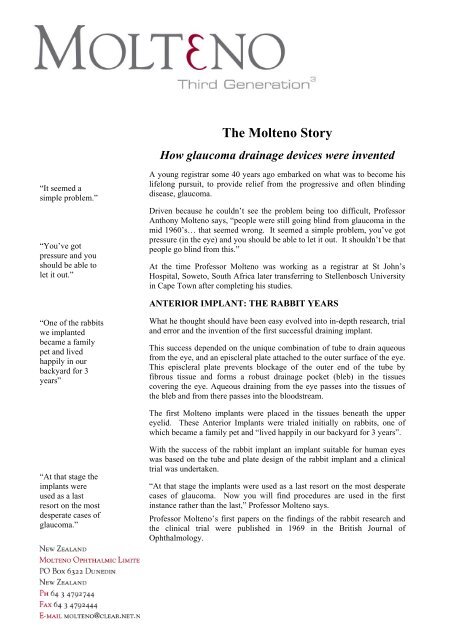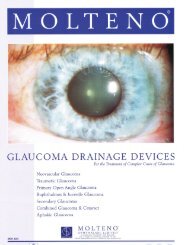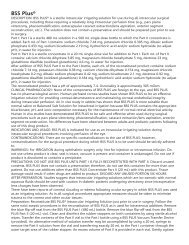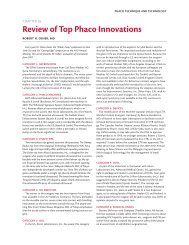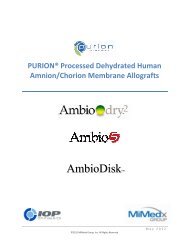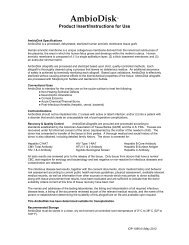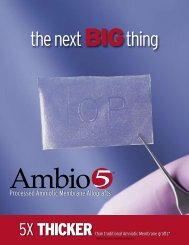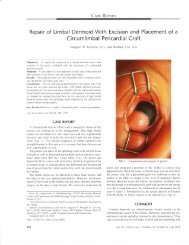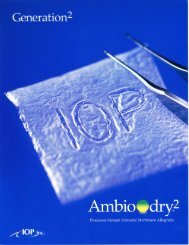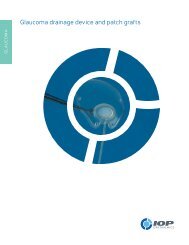You also want an ePaper? Increase the reach of your titles
YUMPU automatically turns print PDFs into web optimized ePapers that Google loves.
The <strong>Molteno</strong> Story<br />
How glaucoma drainage devices were invented<br />
“It seemed a<br />
simple problem.”<br />
“You’ve got<br />
pressure and you<br />
should be able to<br />
let it out.”<br />
A young registrar some 40 years ago embarked on what was to become his<br />
lifelong pursuit, to provide relief from the progressive and often blinding<br />
disease, glaucoma.<br />
Driven because he couldn’t see the problem being too difficult, Professor<br />
Anthony <strong>Molteno</strong> says, “people were still going blind from glaucoma in the<br />
mid 1960’s… that seemed wrong. It seemed a simple problem, you’ve got<br />
pressure (in the eye) and you should be able to let it out. It shouldn’t be that<br />
people go blind from this.”<br />
At the time Professor <strong>Molteno</strong> was working as a registrar at St John’s<br />
Hospital, Soweto, South Africa later transferring to Stellenbosch University<br />
in Cape Town after completing his studies.<br />
ANTERIOR IMPLANT: THE RABBIT YEARS<br />
“One of the rabbits<br />
we implanted<br />
became a family<br />
pet and lived<br />
happily in our<br />
backyard for 3<br />
years”<br />
What he thought should have been easy evolved into in-depth research, trial<br />
and error and the invention of the first successful draining implant.<br />
This success depended on the unique combination of tube to drain aqueous<br />
from the eye, and an episcleral plate attached to the outer surface of the eye.<br />
This episcleral plate prevents blockage of the outer end of the tube by<br />
fibrous tissue and forms a robust drainage pocket (bleb) in the tissues<br />
covering the eye. Aqueous draining from the eye passes into the tissues of<br />
the bleb and from there passes into the bloodstream.<br />
The first <strong>Molteno</strong> implants were placed in the tissues beneath the upper<br />
eyelid. These Anterior Implants were trialed initially on rabbits, one of<br />
which became a family pet and “lived happily in our backyard for 3 years”.<br />
“At that stage the<br />
implants were<br />
used as a last<br />
resort on the most<br />
desperate cases of<br />
glaucoma.”<br />
With the success of the rabbit implant an implant suitable for human eyes<br />
was based on the tube and plate design of the rabbit implant and a clinical<br />
trial was undertaken.<br />
“At that stage the implants were used as a last resort on the most desperate<br />
cases of glaucoma. Now you will find procedures are used in the first<br />
instance rather than the last,” Professor <strong>Molteno</strong> says.<br />
Professor <strong>Molteno</strong>’s first papers on the findings of the rabbit research and<br />
the clinical trial were published in 1969 in the British Journal of<br />
Ophthalmology.
2<br />
MAKING THE IMPLANT<br />
“I don’t think I<br />
could have got as<br />
far as I have,<br />
without having<br />
made the implants<br />
myself.”<br />
“The implants<br />
took a day each to<br />
make.”<br />
“Having control<br />
over intraocular<br />
pressure was<br />
necessary in that<br />
day and age as<br />
many of my<br />
patients were rural<br />
and follow-up was<br />
often difficult.”<br />
“Once we knew<br />
we had an<br />
effective regime<br />
for controlling<br />
bleb fibrosis, we<br />
now knew we<br />
could control<br />
glaucoma,”<br />
With limited options for materials (medical grade silicon and polypropylene<br />
were not yet available), Professor <strong>Molteno</strong> set to work creating his own<br />
implants.<br />
“I don’t think I could have got as far as I have, without having made the<br />
implants myself.”<br />
Professor <strong>Molteno</strong> persuaded a dental technician to make a mold of stainless<br />
steel, and then made the first implants of acrylic.<br />
“The implants took a day each to make; I boiled the plastic for 6 hours with<br />
multiple changes of distilled water to ensure the plastic was inert and would<br />
not cause any severe reactions.”<br />
After having established a suitable way of making implants Professor<br />
<strong>Molteno</strong> was able to use them in a wider range of cases. The implants<br />
controlled the IOP successfully, and in many cases without the need for<br />
pressure lowering medications.<br />
“Having control over intraocular pressure was necessary in that day and age<br />
as many of my patients were rural and follow-up was often difficult.”<br />
ANTI-INFLAMMATORY MEDICATION<br />
With growing experience in using implants Professor <strong>Molteno</strong> found that<br />
while they were able to control IOP in a great number of patients, others,<br />
particularly younger fitter adults, were more difficult as they tended to<br />
produce more inflammation after surgery. This resulted in more fibrous<br />
tissue in the bleb over the implant, restricting drainage of aqueous from the<br />
eye.<br />
For three years Professor <strong>Molteno</strong> trialed various combinations of antiinflammatory<br />
medications to find a way of controlling inflammation postsurgery<br />
that would produce a thinner bleb capsule and relieve post-surgery<br />
inflammation.<br />
The regime created used a combination of low dose medications, potent<br />
when combined, to produce a thin bleb over the plate which drained well<br />
and controlled the intraocular pressure without the need for glaucoma<br />
medication. This anti-inflammatory fibrosis suppression (AIFS) regime was<br />
given for six weeks post operatively.<br />
“Once we knew we had an effective regime for controlling bleb fibrosis, we<br />
now knew we could control glaucoma,” he says.<br />
MOLTENO 2: LONG THIN TUBING 1973<br />
“In some ways we<br />
had to wait for<br />
technology to<br />
catch up.”<br />
The Anterior Implant was technically very demanding to insert. So when<br />
silicon tubing became available the implant was modified to make the<br />
surgery easier.<br />
“In some ways we had to wait for technology to catch up,” Professor<br />
<strong>Molteno</strong> says.
3<br />
Shifting the plate<br />
back in the eye<br />
meant “less chance<br />
of damaging the<br />
bleb.”<br />
“It was only with<br />
recent<br />
advancements in<br />
cell biology that<br />
lets us now<br />
understand the<br />
deposition and<br />
removal of scar<br />
tissue during bleb<br />
formation.”<br />
“I was sure they<br />
just didn’t believe<br />
me.”<br />
The first<br />
neovascular paper<br />
was resubmitted<br />
and published in<br />
the British Journal<br />
of Ophthalmology<br />
in October 1977.<br />
The plate was shifted back in the eye giving room for a larger plate. It was<br />
also safer for the patient.<br />
Setting the plate back in the eye required a long thin tube to connect it to the<br />
anterior chamber and the availability of silicon tubing made this possible.<br />
Professor <strong>Molteno</strong> had reservations about whether the thin tubing would<br />
block, but his reservations never eventuated and the second generation of<br />
Glaucoma Drainage Devices (GDDs) were invented.<br />
MODIFIED TECHNIQUE 1973<br />
As with anything, things do not always go as planned. Professor <strong>Molteno</strong><br />
emphasises that the “errors are how we get it right, and have allowed us to<br />
progress to where we are today.”<br />
One such error was a modification of the surgical technique to divert the<br />
aqueous away from the site of the bleb for the first six weeks after<br />
operation. The aim was to reduce the amount of aqueous entering the bleb<br />
and keep the pressure low allowing the tissue to heal over the plate and<br />
produce a thin walled bleb. After six weeks, when the full amount of<br />
aqueous was redirected into the bleb cavity the IOP rose rapidly to<br />
preoperative levels. This was totally unexpected and the technique was<br />
abandoned.<br />
“It is only with recent advancements in cell biology that we now<br />
understand the factors responsible for the deposition and removal of scar<br />
tissue during bleb formation which explains why this technique was a<br />
failure.”<br />
POLITICAL DIFFICULTIES IN SOUTH AFRICA 1973-77<br />
The Apartheid years made it difficult to get work published or recognised in<br />
the international community. Professor <strong>Molteno</strong> had submitted an article<br />
describing his success in using implants to treat neovascular glaucoma. The<br />
paper was rejected. “I was sure they just didn’t believe me,” he says.<br />
On a scheduled visit to Cape Town, Sir Stephen Miller, the editor of the<br />
British Journal of Ophthalmology, saw some of Professor <strong>Molteno</strong>’s<br />
patients. On observing the results of an implant, he was astounded,<br />
informing the implant patient that “anywhere else in the world you would<br />
have lost your eye.”<br />
Sir Stephen Miller urged Professor <strong>Molteno</strong> to resubmit his paper on<br />
Neovascular Glaucoma, and it was published in the British Journal Of<br />
Medicine in October 1977.<br />
“New Zealand has<br />
social medicine”<br />
“The people here<br />
in New Zealand<br />
are public spirited<br />
and community<br />
minded.”<br />
THE MOVE TO NEW ZEALAND 1977<br />
Prompted by the political situation in South Africa and wanting to extend<br />
his research, Professor <strong>Molteno</strong> and his family moved to New Zealand in<br />
1977, settling their family in Dunedin.<br />
The close proximity of the University and Dunedin Public Hospital together<br />
with the high incidence of glaucoma in Dunedin’s Scottish settlement<br />
provided excellent conditions for long-term study.
4<br />
“I would not have<br />
been able to do the<br />
research without<br />
their support and<br />
the support of their<br />
families.”<br />
As surgeon’s<br />
demand increased,<br />
“Even our children<br />
helped by cutting<br />
the tubing to<br />
exactly the right<br />
length,”<br />
“New Zealand has social medicine”, he says, “and this aided our research”.<br />
“The people here are public spirited and community minded. By donating<br />
their eyes after death my glaucoma patients have helped advance our<br />
understanding and improve our treatment of the disease. I would not have<br />
been able to do the research without their support and the support of their<br />
families” he says.<br />
For quite a few years and with an increasing number of surgeons around the<br />
world requesting the implants, the family made the implants from their own<br />
home. “Even our teenage children helped by cutting the tubing to exactly<br />
the right length,” Professor <strong>Molteno</strong> says.<br />
Later, with help from a Dental Technician and with the use of<br />
polypropylene, (considered the best plastic of the time), production of the<br />
implants became easier.<br />
2 STAGE PROCEDURE 1977<br />
“Hypotony<br />
requires careful<br />
nursing and can<br />
produce serious<br />
complications.”<br />
The two stage<br />
procedure “meant<br />
that we obtained<br />
much lower IOP<br />
and that fewer<br />
patients needed<br />
anti-inflammatory<br />
medication after<br />
surgery.”<br />
“The results were<br />
gratifying.”<br />
We “increased the<br />
area of the plates<br />
by linking plates<br />
together.”<br />
Using implants combined with anti-inflammatory medication in selected<br />
cases, Professor <strong>Molteno</strong> was able to control the IOP in the majority of<br />
cases, even the most severe and complex types of glaucoma.<br />
There remained the problem of hypotony, that is, a period of excessive<br />
drainage that occasionally follows glaucoma surgery, especially if the eye<br />
has had several previous surgeries. “Hypotony requires careful nursing and<br />
can produce serious complications,” he said.<br />
Professor <strong>Molteno</strong> solved this problem very neatly through using a 2-stage<br />
procedure, a modification of the surgical technique used to insert the<br />
implant. This technique divided the implant surgery into two separate<br />
operations. In the first operation the plate of the implant was attached to the<br />
eyeball and covered by the tissues. The tube of the implant was not inserted<br />
into the eye at this time but tucked away under a rectus muscle. Five to six<br />
weeks later in a second much shorter operation the free end of the tube was<br />
uncovered and inserted into the anterior chamber of the eye.<br />
This technique gave the tissues time to heal around the plate of the implant<br />
and form a thin fibrous bleb capsule. When the tube was inserted into the<br />
eye at the second operation, this pre-formed bleb capsule offered sufficient<br />
resistance to the escape of aqueous to prevent hypotony.<br />
Professor <strong>Molteno</strong> says, “an unexpected advantage of this technique was<br />
that we found that pre-forming the bleb capsule in this way reduced the<br />
amount of bleb scarring. This meant that we obtained much lower IOP and<br />
that fewer patients needed anti-inflammatory medication after surgery. The<br />
results were gratifying.”<br />
MULTIPLE PLATES 1981<br />
The 2-stage procedure gave Professor <strong>Molteno</strong> the chance to increase the<br />
area of the plates by linking plates together. He found that four plates were<br />
too many but one or two were excellent. This gave him the opportunity to<br />
select the ideal drainage area for different cases with younger, fitter patients
5<br />
generally needing a greater drainage area than the very elderly.<br />
“Again we had to<br />
wait until<br />
advancements<br />
were made in the<br />
knowledge of cell<br />
biology …and<br />
that’s when<br />
everything fitted<br />
into place”.<br />
“It soon became<br />
the procedure of<br />
choice.”<br />
The tissues<br />
covered the plate<br />
acting as<br />
“biological valve.”<br />
“The benefits of<br />
<strong>Molteno</strong>3 include<br />
a 20% reduction in<br />
estimated surgery<br />
time, reduced risk<br />
of hypotony, and<br />
improved long<br />
term control of<br />
intraocular<br />
pressure.”<br />
“Different stages<br />
of the implant<br />
have produced<br />
improved<br />
scientific<br />
understanding”<br />
ABSORBABLE POLYGLYCOLIC ACID SUTURES - THE<br />
VICRYL TIE 1986<br />
The 2-stage procedure was greatly simplified when absorbable polyglycolic<br />
acid sutures (for example, Vicryl) were invented. These sutures, when<br />
placed in the tissues dissolve after four weeks or so.<br />
Professor <strong>Molteno</strong> found that instead of having to do two separate<br />
operations he could achieve the advantages of a 2-stage procedure in one<br />
operation by tying an absorbable suture around the tube of the implant<br />
(temporarily closing the tube) before inserting it into the eye. This allowed<br />
the tissues to heal around the implant for about 4 weeks before the suture<br />
dissolved and aqueous drained into the pre-formed bleb capsule.<br />
While this technique was very successful they still didn’t understand why.<br />
“Again we had to wait until advances were made in the knowledge of cell<br />
biology to understand completely the formation of scar tissue around the<br />
bleb and that’s when everything fitted into place.”<br />
“It soon became the procedure of choice among the majority of glaucoma<br />
surgeons,” said Professor <strong>Molteno</strong>.<br />
PRESSURE RIDGE IMPLANT 1990<br />
The Vicryl-tie technique was very successful in reducing post-operative<br />
hypotony and in providing a thin bleb that drained well in cases where the<br />
patient could tolerate a delay in the onset of drainage.<br />
In eyes with neovascular glaucoma however, immediate drainage is vital if<br />
the eye is not to go blind. To prevent post-operative hypotony in these<br />
cases a subsidiary ridge was added to the upper surface of the plate, forming<br />
a small primary drainage area to receive the aqueous from the eye. The<br />
tissue covering the plate acted as a “biological valve” by pressing on the<br />
ridge and restricting the aqueous to this small area within the ridge until the<br />
pressure rose enough to lift the tissue off the plate allowing aqueous into the<br />
main bleb cavity.<br />
MOLTENO3<br />
<strong>Molteno</strong>3 is a refinement in the design of the current glaucoma drains. This<br />
is made possible through international advances in the understanding of cell<br />
biology and the findings from the past decade of research undertaken with<br />
Professor <strong>Molteno</strong>’s supervision, a near impossibility if it weren’t for the<br />
donation of eyes from community minded New Zealanders.<br />
“<strong>Molteno</strong>3’s advanced technology includes a slightly larger plate and<br />
thinner design which makes it easier to insert on the surface of the eye."<br />
Professor <strong>Molteno</strong> said.<br />
<strong>Molteno</strong>3 offers substantial advantages to patients as well as to the surgeons<br />
implanting them.<br />
“The benefits include an estimated 20% reduction in surgery time, reduced<br />
risk of hypotony, and improved long-term control of intraocular pressure”,
6<br />
he said.<br />
“It’s easy to put in,<br />
it knows its place.”<br />
“We now know the main factors which lead to the success or failure of<br />
drainage surgery and implants in particular, and have been able to use this<br />
knowledge in the development of the third generation glaucoma drains,”<br />
Professor <strong>Molteno</strong> said.<br />
Professor <strong>Molteno</strong> has been monitoring the success of his drainage devices<br />
for over 30 years and he is confident that the third generation of devices will<br />
further increase success rates, and will be substantially easier to implant.<br />
“You don’t learn<br />
anything from<br />
admiring your<br />
successes”<br />
“An awful lot of<br />
medicine is<br />
knowing when to<br />
operate and when<br />
not to operate. The<br />
best medicine is<br />
long-term follow<br />
up.”<br />
Demand for<br />
implants grew<br />
rapidly…<br />
Twenty-seven <strong>Molteno</strong>3 devices have been implanted in patients so far, the<br />
first being in January 2004. The results to date show the implant is working<br />
very well and surgeons implanting the new <strong>Molteno</strong>3 have been delighted<br />
by how quick and easy it is to insert. At the RANZCO NZ Branch<br />
Conference held this month in Dunedin Professor <strong>Molteno</strong> explained the<br />
promising results received from initial clinical trial of <strong>Molteno</strong>3 implants<br />
showing reduced IOP and medication compared in a matched series of<br />
cases.<br />
The <strong>Molteno</strong>3 glaucoma drain is scheduled for release in the second half of<br />
this year and selected surgeons around the world will be given <strong>Molteno</strong>3’s<br />
to implant in patients within the next few months.<br />
REFLECTING<br />
Having trained an average of one surgeon per year for the last 30 years,<br />
surgeons that have trained under Professor <strong>Molteno</strong>, can be found in most<br />
countries around the world.<br />
A rather modest Professor <strong>Molteno</strong> said, “You don’t learn anything from<br />
admiring your successes, it’s the second sin of surgeons. You learn a lot<br />
from your failures if you can bring yourself to look honestly at them.”<br />
“When things have gone unexpectedly like the failure of the modified<br />
technique, it sits in the back of your mind for years. Nearly 40 years later<br />
you know why, because technology has caught up.”<br />
MOLTENO OPHTHALMIC LIMITED 1980<br />
..when demand<br />
increased so much<br />
he could no longer<br />
make all the<br />
implants himself,<br />
the implant<br />
production was<br />
outsourced.<br />
<strong>Molteno</strong> Ophthalmic Limited (MOLTENO) is a privately owned, limited<br />
liability company. The company was established in 1980 when Professor<br />
<strong>Molteno</strong> applied for and received a grant from the Development and<br />
Finance Corporation of New Zealand to patent the double plate form of the<br />
drain.<br />
At this time Professor <strong>Molteno</strong> was supplying his glaucoma drains to<br />
colleagues in various parts of the world that he had worked with or who had<br />
heard of the drains and wanted to use them.<br />
Demand for the implants grew rapidly and in 1986, when volumes increased<br />
so much he could no longer make all the implants himself, the implant
7<br />
Tess <strong>Molteno</strong><br />
became the driving<br />
force behind the<br />
company.<br />
production was outsourced to a resourceful dental technician.<br />
In 1992 with growing demand internationally for quality assurance in the<br />
manufacture of medical devices the company built a class 350 clean-room<br />
production facility on its present site conveniently close to both the<br />
University of Otago and Dunedin Public Hospital.<br />
Professor <strong>Molteno</strong>’s wife Tess <strong>Molteno</strong> became the driving force behind the<br />
company, leaving the Professor to further pursue his life’s work of<br />
performing operations, teaching, and researching.<br />
<strong>Molteno</strong> Ophthalmic Limited employs six dedicated staff to service a<br />
worldwide market, exporting up to 90% of their implants through a <strong>net</strong>work<br />
of distributors and agents.<br />
There is more to<br />
be done. “We<br />
haven’t solved old<br />
age.”<br />
THE FUTURE<br />
When asked of the future of <strong>Molteno</strong> Ophthalmic Ltd, Professor <strong>Molteno</strong> is<br />
optimistic that further advances can be made with the help of the New<br />
Zealand community in assisting research by donating their eyes. Their<br />
extensive database with a 97% follow-up rate is practically unheard of, and<br />
the largest database of implants to their knowledge in the world. This<br />
provides an excellent source of information for the future of glaucoma<br />
research.<br />
Professor <strong>Molteno</strong> admits, “we have already improved the outlook for<br />
certain groups of patients enormously.” But he knows there is more to be<br />
done. “We haven’t solved old age. Most glaucomas are diseases of old<br />
age.”<br />
For further information regarding <strong>Molteno</strong>3 please refer to<br />
www.molteno.com<br />
Janine Hunter<br />
<strong>Molteno</strong> Ophthalmic Limited<br />
PO Box 6322<br />
Dunedin<br />
New Zealand<br />
Ph 64 3 479 2744<br />
Fax 64 3 479 2444<br />
Email sales@molteno.com


